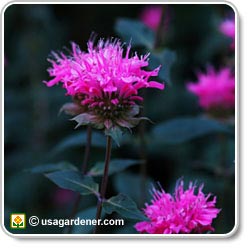 |
PLANT TYPE: Perennial SCIENTIFIC NAME: Monarda didyma ZONE / HARDINESS: 4 to 9. MATURE PLANT SIZE: 24 to 48 inches high x 12 inches wide LIGHT: Sunny location or in partial-day shade FLOWERING PERIOD: July to August SOIL TYPE: Rich, moist soil pH RANGE: 6.5 KNOWN PESTS: Snails can be a problem in shady, moist locations where roots are kept cool and moist. KNOWN DISEASES: N/A |
OVERVIEW:
The tuberous root produces an erect, slightly hairy square stem with a citruslike fragrance. The two-lipped scarlet flowers rest on a collar of red-tinged bracts with solitary terminal heads. The dark green leaves are 3 to 6 inches long, opposite, and ovate with serrated margins. The fruit is comprised of four nutlets resembling seeds.
Native to North America, bergamot received its botanical name from the sixteenth century Spanish physician, Nicholas Monardez, who first discovered and described it. It was called Oswego (or Otsego) tea by early American settlers because of its use by the Oswego Indians. Today, bergamot is also known as scarlet bee balm.
PROPAGATION / SOWING:
Seeds or division in spring and cuttings in summer. Seeds or division in spring and cuttings in summer. Sow seed in warm soil, 1/8 inch deep and 12 inches apart. Germination in about 2 weeks.
COMPANION PLANTING:
Bergamot attracts bees, making it an excellent plant to grow near vegetable gardens or orchards.
CARE & GROWING:
When the plant begins to shoot up in the spring, a dressing of well-decayed humus can be applied. Sprinkle grass clippings over the root area during the hottest part of summer. If necessary, lightly tie the slender and sometimes brittle stems with garden stakes. Bergamot can be grown in clumps or masses for a nice effect as a background plant. Planting 18 inches apart would allow plenty of room.
USAGE:
Aromatic, cosmetic, culinary, decorative, and medicinal.Dried leaves and flowers are used to scent sachets and potpourris. Bergamot also is used in lotions and baths. The leaves are used for tea and the flowers for salads or with fruit. With its long-lasting flowers, the plant itself is decorative. It is said to have some medicinal qualities.
NOTES:
Bergamot attract butterflies, and the deep purple variety was especially popular with visitors to our garden. Support may be needed if the plants become top-heavy.